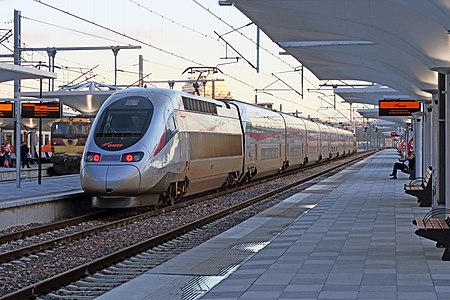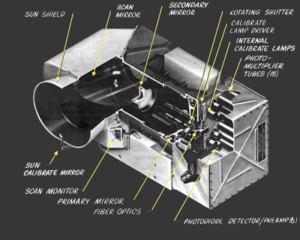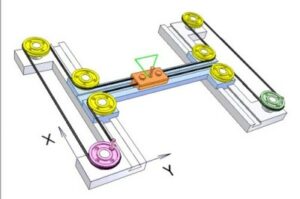In the 21st century, the global transportation landscape is in shift. Politicians, engineers, and planners all want to move more people, more quickly, more cleanly. Amid the frenzy of innovative harebrained ideas, high-speed rail travel has surged to the forefront. It’s a quiet achiever, and a reliable solution for efficient, sustainable, and swift intercity and intercountry transit.
From the thriving economies of Europe and Asia to the burgeoning markets of the Middle East and America, high-speed rail networks are being planned, expanded, and upgraded whichever way you look. A combination of traditional and magnetic levitation (maglev) trains are being utilized, reaching speeds that were once the stuff of science fiction. As we set our sights towards the future, it’s worth taking a snapshot of the current state of high-speed rail, a field where technology, engineering brilliance, and visions of a greener tomorrow converge.
Rail Away
Morocco operates a handsome high-speed rail system running Alstom trainsets at up to 305 km/h. Credit: NicholasNCE, CC BY-SA 4.0
” data-medium-file=”https://platoaistream.com/wp-content/uploads/2023/08/the-state-of-high-speed-rail-and-a-look-to-tomorrow.jpg?w=400″ data-large-file=”https://platoaistream.com/wp-content/uploads/2023/08/the-state-of-high-speed-rail-and-a-look-to-tomorrow.jpg?w=450″ decoding=”async” loading=”lazy” class=”size-full wp-image-606866″ src=”https://platoaistream.com/wp-content/uploads/2023/08/the-state-of-high-speed-rail-and-a-look-to-tomorrow.jpg” alt width=”450″ height=”300″ srcset=”https://platoaistream.com/wp-content/uploads/2023/08/the-state-of-high-speed-rail-and-a-look-to-tomorrow.jpg 450w, https://platoaistream.com/wp-content/uploads/2023/08/the-state-of-high-speed-rail-and-a-look-to-tomorrow.jpg?resize=250,167 250w, https://platoaistream.com/wp-content/uploads/2023/08/the-state-of-high-speed-rail-and-a-look-to-tomorrow.jpg?resize=400,267 400w” sizes=”(max-width: 450px) 100vw, 450px”>
When talking about high-speed rail, different authorities and jurisdictions use different terminology. Generally, though, few people will disagree with you classifying a system as “high-speed rail” if it involves speeds over 250 km/h (155 mph). Trains that are fast, but not that fast, are given the diminutive title of “higher-speed rail” to indicate services that operate faster than traditional railways, but not excessively so.
Japan was the first country to develop a working high-speed rail network by the modern definition, with its world-famous Shinkansen lines. The country was a leader in rail technology for a long time, with its first-generation 0 Series trains capable of achieving 210 km/h in revenue service as early as 1964. That was shortly bumped up to 220 km/h, and incremental improvement has continued ever since. Today, the fastest Shinkansen lines operate at up to 320 km/h. In tests run in 1996, a conventional Shinkansen train reached a top speed of 443 km/h, but regular services don’t approach this higher figure.
China’s railways operate trains at up to 350 km/h in regular operation. New trainsets are in development to achieve 400 km/h in coming years. Credit: Junyi Lou, CC BY-SA 4.0
” data-medium-file=”https://platoaistream.com/wp-content/uploads/2023/08/the-state-of-high-speed-rail-and-a-look-to-tomorrow-1.jpg?w=400″ data-large-file=”https://platoaistream.com/wp-content/uploads/2023/08/the-state-of-high-speed-rail-and-a-look-to-tomorrow-1.jpg?w=800″ decoding=”async” loading=”lazy” class=”size-full wp-image-606867″ src=”https://platoaistream.com/wp-content/uploads/2023/08/the-state-of-high-speed-rail-and-a-look-to-tomorrow-1.jpg” alt width=”800″ height=”600″ srcset=”https://platoaistream.com/wp-content/uploads/2023/08/the-state-of-high-speed-rail-and-a-look-to-tomorrow-1.jpg 3838w, https://platoaistream.com/wp-content/uploads/2023/08/the-state-of-high-speed-rail-and-a-look-to-tomorrow-1.jpg?resize=250,187 250w, https://platoaistream.com/wp-content/uploads/2023/08/the-state-of-high-speed-rail-and-a-look-to-tomorrow-1.jpg?resize=400,300 400w, https://platoaistream.com/wp-content/uploads/2023/08/the-state-of-high-speed-rail-and-a-look-to-tomorrow-1.jpg?resize=800,600 800w, https://platoaistream.com/wp-content/uploads/2023/08/the-state-of-high-speed-rail-and-a-look-to-tomorrow-1.jpg?resize=1536,1152 1536w, https://platoaistream.com/wp-content/uploads/2023/08/the-state-of-high-speed-rail-and-a-look-to-tomorrow-1.jpg?resize=2048,1536 2048w” sizes=”(max-width: 800px) 100vw, 800px”>
It’s a common refrain in other services around the world. France’s famous TGV runs at a top speed of 320 km/h in service, as does the ONCF Al Boraq line in Morocco. Spain and Korea run their respective networks at a maximum of 310 and 305 km/h respectively. German trains on the Intercity Express system are authorized to run at up to 330 km/h, but only to overcome delays on the Frankfurt to Cologne line. Otherwise, the national maximum is similarly 320 km/h.
Several record attempts were made by SNCF using various TGV trainsets over the years. These attempts involved overvolting the network, heavily modifying the trains, and thousands of engineering hours. Credit: Alain Stoll, CC BY-SA 2.0
” data-medium-file=”https://platoaistream.com/wp-content/uploads/2023/08/the-state-of-high-speed-rail-and-a-look-to-tomorrow-2.jpg” data-large-file=”https://platoaistream.com/wp-content/uploads/2023/08/the-state-of-high-speed-rail-and-a-look-to-tomorrow-11.jpg?w=800″ decoding=”async” loading=”lazy” class=”wp-image-606868 size-medium” src=”https://platoaistream.com/wp-content/uploads/2023/08/the-state-of-high-speed-rail-and-a-look-to-tomorrow-2.jpg” alt width=”400″ height=”268″ srcset=”https://platoaistream.com/wp-content/uploads/2023/08/the-state-of-high-speed-rail-and-a-look-to-tomorrow-11.jpg 1280w, https://platoaistream.com/wp-content/uploads/2023/08/the-state-of-high-speed-rail-and-a-look-to-tomorrow-11.jpg?resize=250,167 250w, https://platoaistream.com/wp-content/uploads/2023/08/the-state-of-high-speed-rail-and-a-look-to-tomorrow-11.jpg?resize=400,268 400w, https://platoaistream.com/wp-content/uploads/2023/08/the-state-of-high-speed-rail-and-a-look-to-tomorrow-11.jpg?resize=800,536 800w” sizes=”(max-width: 400px) 100vw, 400px”>
China likes to run things a little faster, however. The country has fallen in love with high-speed rail in recent decades. By mileage, it now hosts over two-thirds of all the high-speed rail in the world. The country’s CR Fuxing trainsets regularly run at up to 350 km/h, and were the first models produced domestically without proprietary licensed technology from overseas manufacturers. They’ve clocked speeds up to 420 km/h in testing. The country’s CRH Hexie trains run at the same speed, but have been even faster in testing, with an unmodified example recording a maximum of 487 km/h.
In fact, most rail operators have attempted maxing out their high-speed trains at some time or other. France’s SNCF is well-known for running highly-modified TGV trains to chase glory, claiming the outright steel rail speed record in 2007. A heavily-modified TGV POS consist achieved a mighty figure of 574.8 km/h, fitted with larger wheels and running on an overhead line overvolted from 25 kV to 31 kV. The trainset was named V150, for the target speed of 150 meters per second (540 km/h).
Limits of Steel
The fact is that most high-speed railways have trains capable of very high speeds indeed, but regular services run at a more sedate pace for a number of reasons. While it’s possible for many high-speed trainsets to push beyond 400 km/h, these speeds are never achieved in regular service.
The French history of chasing records highlights some of the challenges in running trains on steel rails at higher speeds. For example, the catenary wires that supply electricity can cause problems. The wires are excited with a wave-like disturbance by the contact of the train’s pantograph. This wave travels at the speed determined by the wire’s mass per unit length and its tension. If the train travels fast enough to catch this wave, it can lead to large vertical oscillations of the caternary wire, causing damage or a loss of power delivery to the train. A 1990 record attempt massively increased the tension on caternary wires to avoid this problem, increasing the critical speed of the caternary. Even still, gauges recorded the caternary wires oscillating by almost 30 cm as the train reached speeds of 515 km/h.
A more common problem for high speed trains is tunnel boom, caused by the piston effect. As a train enters a tunnel, the air in front has nowhere else to go, barring the small gap between the train and the tunnel itself. The train ends up acting like a piston in a cylinder, forcing air along in front. For high-speed trains, this can create a shock wave that creates a large boom when it reaches the exit of the tunnel. The strength of the shock wave increases with the cube of the train’s velocity, so higher speeds create massively higher shocks. Techniques to reduce this involve aerodynamically profiling trains and venting tunnels, akin to putting a silencer on a firearm. Regardless, this issue plagues efforts in Japan, Spain, France, and elsewhere, to push their high speed lines to faster operating speeds.
Futhermore, the steel tracks themselves must be perfectly aligned in order to support high-speed running. For example, the TGV network aligns rails to a tolerance of just 1 mm. Achieving and maintaining that over an entire network is costly. Higher speeds require finer tolerances and more regular maintenance, as a faster moving train necessarily causes greater wear as it puts more energy into the track.
By and large, rail operators have done the sums on the benefits of faster running versus the costs involved. Most have landed on regular operational speeds in the realm of 300 to 350 km/h. That’s fast enough to make their services compelling, but reasonable enough to keep the lines operating in a sustainable fashion.
Let’s Go Faster
China currently operates a relatively dull looking maglev train to Pudong International Airport in Shanghai. It’s capable of reaching 430 km/h, but you wouldn’t know from looking at it. Credit: Alex Needham, public domain
” data-medium-file=”https://platoaistream.com/wp-content/uploads/2023/08/the-state-of-high-speed-rail-and-a-look-to-tomorrow-3.jpg” data-large-file=”https://platoaistream.com/wp-content/uploads/2023/08/the-state-of-high-speed-rail-and-a-look-to-tomorrow-14.jpg?w=800″ decoding=”async” loading=”lazy” class=”wp-image-606864 size-medium” src=”https://platoaistream.com/wp-content/uploads/2023/08/the-state-of-high-speed-rail-and-a-look-to-tomorrow-3.jpg” alt width=”400″ height=”215″ srcset=”https://platoaistream.com/wp-content/uploads/2023/08/the-state-of-high-speed-rail-and-a-look-to-tomorrow-14.jpg 1920w, https://platoaistream.com/wp-content/uploads/2023/08/the-state-of-high-speed-rail-and-a-look-to-tomorrow-14.jpg?resize=250,135 250w, https://platoaistream.com/wp-content/uploads/2023/08/the-state-of-high-speed-rail-and-a-look-to-tomorrow-14.jpg?resize=400,215 400w, https://platoaistream.com/wp-content/uploads/2023/08/the-state-of-high-speed-rail-and-a-look-to-tomorrow-14.jpg?resize=800,431 800w, https://platoaistream.com/wp-content/uploads/2023/08/the-state-of-high-speed-rail-and-a-look-to-tomorrow-14.jpg?resize=1536,827 1536w” sizes=”(max-width: 400px) 100vw, 400px”>
As the new world leader in high-speed rail, China has a bevy of projects on the boil to push its rail networks to ever-higher speeds. The China State Railway Group has released provisional specifications for its new CR450 trainset, intended to reach operational speeds of up to 400 km/h. This level of operation poses new operation challenges, requiring new standards for signalling and track monitoring systems. Additionally, a great deal of effort is going into reducing noise in the cabin; typically, a train travelling at 400 km/h is a full 3 dB louder than at 350 km/h. Testing has already seen two CR400BF-J testbed trainsets run in opposing directions at 435 km/h to determine any risks involved at high passing speeds. The world-record closing speed of 870 km/h was achieved without incident.
China is also investing big in maglev technology, which promises higher speeds with magnetically-floated trains while eliminating the frustrations of caternary wires, rails, and wheels. The Shanghai Maglev has been in commercial operation since 2004, and regularly attains a maximum speed of 430 km/h. It only runs on a short 29.9 km track, with a ride that lasts just 8 minutes. Regardless, it blitzes all rail competition in terms of regular operational top speed. The line was once slated for expansion, but regular rail services have stymied efforts to push it beyond its current run that serves Pudong International Airport.
China has more serious maglev ambitions, though, recently rolling out a test train reportedly capable of a 600 km/h top speed. The train is based on the Transrapid maglev technology from Germany. Initially expected to enter service by 2025, current plans for an operational maglev network remain unclear. Some commentators expect the new train will be used first on corridors between Guangzhou and Shenzhen and Shanghai and Hangzhou, where passenger flows are expected to be high enough to support the expense of constructing the advanced maglev “track.”
The L0 Series maglev holds the outright train speed record at 603 km/h. Concrete plans exist for it to enter commercial service before the decade is out. Credit: Saruno Hirobano, CC-BY-SA-4.0
” data-medium-file=”https://platoaistream.com/wp-content/uploads/2023/08/the-state-of-high-speed-rail-and-a-look-to-tomorrow-4.jpg?w=400″ data-large-file=”https://platoaistream.com/wp-content/uploads/2023/08/the-state-of-high-speed-rail-and-a-look-to-tomorrow-4.jpg?w=800″ decoding=”async” loading=”lazy” class=”size-full wp-image-606863″ src=”https://platoaistream.com/wp-content/uploads/2023/08/the-state-of-high-speed-rail-and-a-look-to-tomorrow-4.jpg” alt width=”800″ height=”450″ srcset=”https://platoaistream.com/wp-content/uploads/2023/08/the-state-of-high-speed-rail-and-a-look-to-tomorrow-4.jpg 1251w, https://platoaistream.com/wp-content/uploads/2023/08/the-state-of-high-speed-rail-and-a-look-to-tomorrow-4.jpg?resize=250,141 250w, https://platoaistream.com/wp-content/uploads/2023/08/the-state-of-high-speed-rail-and-a-look-to-tomorrow-4.jpg?resize=400,225 400w, https://platoaistream.com/wp-content/uploads/2023/08/the-state-of-high-speed-rail-and-a-look-to-tomorrow-4.jpg?resize=800,450 800w” sizes=”(max-width: 800px) 100vw, 800px”>
While it lacks an operational public maglev line, Japan is perhaps still leading in this area. The country has developed the L0 Series maglev train, which currently holds the world speed record for rail vehicles at 603 km/h. Firm plans exist for a maglev network, with construction beginning in 2014. The initial section linking Tokyo to Nagoya was initially expected to open in 2027, though the start date for commercial service is yet to be confirmed. The Nagoya-Osaka section is expected to follow in 2037. Trains are expected to run at an operational speed of 500 km/h, shortening the travel time between Tokyo and Osaka to just 67 minutes. It’s a stark time saving compared to the 4 hour trip achieved by the first Shinkansen trains in 1964.
Australia has never built a high-speed rail line, though the Electric Tilt Train reached 210 km/h in a test run. Regular services are limited to 160 km/h. Credit: John Robert McPherson, CC BY-SA 4.0.
” data-medium-file=”https://platoaistream.com/wp-content/uploads/2023/08/the-state-of-high-speed-rail-and-a-look-to-tomorrow-5.jpg” data-large-file=”https://platoaistream.com/wp-content/uploads/2023/08/the-state-of-high-speed-rail-and-a-look-to-tomorrow-20.jpg?w=800″ decoding=”async” loading=”lazy” class=”wp-image-606865 size-medium” src=”https://platoaistream.com/wp-content/uploads/2023/08/the-state-of-high-speed-rail-and-a-look-to-tomorrow-5.jpg” alt width=”400″ height=”279″ srcset=”https://platoaistream.com/wp-content/uploads/2023/08/the-state-of-high-speed-rail-and-a-look-to-tomorrow-20.jpg 1920w, https://platoaistream.com/wp-content/uploads/2023/08/the-state-of-high-speed-rail-and-a-look-to-tomorrow-20.jpg?resize=250,174 250w, https://platoaistream.com/wp-content/uploads/2023/08/the-state-of-high-speed-rail-and-a-look-to-tomorrow-20.jpg?resize=400,279 400w, https://platoaistream.com/wp-content/uploads/2023/08/the-state-of-high-speed-rail-and-a-look-to-tomorrow-20.jpg?resize=800,558 800w, https://platoaistream.com/wp-content/uploads/2023/08/the-state-of-high-speed-rail-and-a-look-to-tomorrow-20.jpg?resize=1536,1072 1536w” sizes=”(max-width: 400px) 100vw, 400px”>
Presently, Asia is streaking ahead with the latest technologies and the most railways, while Spain has cracked the code for cheap high-speed rail, both in terms of ticket prices and construction. Meanwhile, Morocco has brought high-speed rail to Africa, with countries like Iran and Chile eager to join the party. The US lags behind, with California taking its time to establish a run, but it’s on the way. Meanwhile, Australians chuckle as the idea is meaninglessly floated as a bullet point every time a new election rolls around.
Viewed globally, however, the future of high-speed rail is bright. It promises clean and efficient transit at speeds that are fast enough to make air travel less desirable. As the world looks to reduce emissions and move more people than ever, high speed rail promises to keep delivering. Japan, China, and Europe all offer a shining example of its value; those eager to have it need only find suitable corridors and the political will to sign the checks. Easier said than done!
Featured image: “CR400BF” by N509FZ.
- SEO Powered Content & PR Distribution. Get Amplified Today.
- PlatoData.Network Vertical Generative Ai. Empower Yourself. Access Here.
- PlatoAiStream. Web3 Intelligence. Knowledge Amplified. Access Here.
- PlatoESG. Automotive / EVs, Carbon, CleanTech, Energy, Environment, Solar, Waste Management. Access Here.
- BlockOffsets. Modernizing Environmental Offset Ownership. Access Here.
- Source: https://hackaday.com/2023/08/03/the-state-of-high-speed-rail-and-a-look-to-tomorrow/
- :has
- :is
- :not
- :where
- $UP
- 1
- 160
- 167
- 1996
- 2014
- 2025
- 2037
- 21st
- 220
- 25
- 250
- 30
- 300
- 31
- 320
- 420
- 500
- 67
- 8
- 9
- a
- About
- Achieve
- achieved
- achieving
- acting
- Additionally
- advanced
- africa
- ahead
- AIR
- air travel
- airport
- AL
- alex
- aligned
- Aligns
- All
- along
- already
- also
- ambitions
- america
- Amid
- an
- and
- any
- approach
- ARE
- AREA
- around
- AS
- asia
- At
- attempted
- Attempts
- Authorities
- authorized
- avoid
- based
- BE
- been
- before
- Beginning
- behind
- being
- benefits
- between
- Beyond
- Big
- boom
- both
- Bright
- brought
- built
- but
- by
- CAN
- capable
- Catch
- Category
- Cause
- caused
- causes
- causing
- Century
- challenges
- chase
- cheap
- Checks
- China
- claiming
- clear
- closing
- CNN
- code
- Cologne
- combination
- coming
- commentators
- commercial
- Common
- compared
- compelling
- competition
- CONFIRMED
- constructing
- construction
- contact
- continued
- conventional
- converge
- costly
- Costs
- countries
- country
- country’s
- cracked
- create
- creates
- credit
- critical
- Current
- Current state
- Currently
- damage
- Date
- deal
- decade
- decades
- definition
- delays
- delivering
- delivery
- Determine
- determined
- develop
- developed
- Development
- different
- directions
- does
- domestically
- done
- Dont
- eager
- Early
- easier
- East
- economies
- effect
- efficient
- effort
- efforts
- Election
- Electric
- electricity
- eliminating
- else
- elsewhere
- Emissions
- ends
- energy
- Engineering
- Engineers
- enough
- ensure
- Enter
- Enters
- Entire
- establish
- Ether (ETH)
- Europe
- Even
- EVER
- example
- excessively
- excited
- exist
- Exit
- expanded
- expansion
- expect
- expected
- express
- fact
- Fallen
- famous
- Fashion
- FAST
- faster
- fastest
- few
- Fiction
- field
- Figure
- Find
- Firm
- firmly
- First
- Flows
- follow
- For
- forefront
- France
- French
- frenzy
- from
- front
- Frustrations
- full
- future
- gap
- generally
- German
- Germany
- given
- Global
- Globally
- Go
- going
- great
- greater
- Group
- Guangzhou
- Have
- heavily
- High
- higher
- Highlight
- highlights
- history
- holds
- hosts
- hour
- HOURS
- However
- HTML
- HTTPS
- idea
- ideas
- if
- image
- improvement
- in
- In other
- incident
- increased
- Increases
- increasing
- indicate
- initial
- initially
- innovative
- International
- into
- investing
- involve
- involved
- iPhone
- issue
- IT
- ITS
- itself
- Japan
- John
- join
- jpg
- jurisdictions
- just
- Keep
- Know
- korea
- landscape
- large
- larger
- latest
- lead
- leader
- leading
- Length
- less
- Level
- Licensed
- like
- likes
- Limited
- Line
- lines
- linking
- little
- Long
- long time
- Look
- looking
- LOOKS
- loss
- love
- made
- maintaining
- maintenance
- make
- Manufacturers
- many
- Markets
- Mass
- massively
- max-width
- maximum
- Meanwhile
- Middle
- Middle East
- mighty
- minutes
- models
- Modern
- monitoring
- more
- morocco
- most
- move
- moving
- must
- Named
- National
- necessarily
- Need
- network
- networks
- never
- New
- Noise
- now
- number
- of
- offer
- often
- on
- once
- only
- open
- operate
- operates
- operating
- operation
- operational
- operators
- or
- order
- Other
- otherwise
- our
- out
- over
- Overcome
- overseas
- Pace
- party
- Passing
- People
- per
- perhaps
- Places
- Plagues
- planned
- plans
- plato
- Plato Data Intelligence
- PlatoData
- Point
- political
- Politicians
- PoS
- poses
- possible
- power
- Problem
- problems
- Produced
- profiling
- projects
- promises
- proprietary
- provisional
- public
- Push
- Puts
- Putting
- quickly
- Rail
- rails
- Railway
- railways
- reach
- reached
- Reaches
- reaching
- realm
- reasonable
- reasons
- recent
- record
- recorded
- recording
- records
- reduce
- reducing
- Regardless
- regular
- regularly
- relatively
- released
- reliable
- remain
- require
- respective
- Respective Networks
- respectively
- revenue
- Ride
- risks
- ROBERT
- Rolling
- rolls
- Run
- running
- runs
- Said
- same
- saving
- Science
- Science Fiction
- Second
- Section
- seen
- Series
- serious
- serves
- service
- Services
- serving
- set
- shanghai
- shenzhen
- shift
- Short
- Shortly
- Sights
- sign
- Similarly
- since
- small
- Snapshot
- So
- solution
- some
- Spain
- specifications
- speed
- speeds
- standards
- stark
- start
- State
- steel
- Still
- strength
- suitable
- sums
- supply
- support
- Surged
- sustainable
- SWIFT
- system
- Systems
- taking
- talking
- Target
- techniques
- Technologies
- Technology
- terminology
- terms
- test
- Test run
- Testing
- tests
- than
- that
- The
- the cabin
- The Future
- The State
- the world
- their
- themselves
- These
- things
- this
- those
- though?
- thousands
- thriving
- time
- Title
- to
- today
- tokyo
- tolerance
- tomorrow
- top
- towards
- track
- traditional
- Train
- trains
- transit
- transportation
- travel
- travels
- trip
- tunnel
- two
- two-thirds
- typically
- unit
- upgraded
- us
- use
- used
- using
- utilized
- value
- various
- Vehicles
- VeloCity
- Versus
- vertical
- very
- visions
- want
- was
- Wave
- Way..
- we
- well-known
- were
- when
- which
- while
- Wikipedia
- will
- Wire
- with
- without
- working
- world
- worth
- years
- yet
- you
- youtube
- zephyrnet












